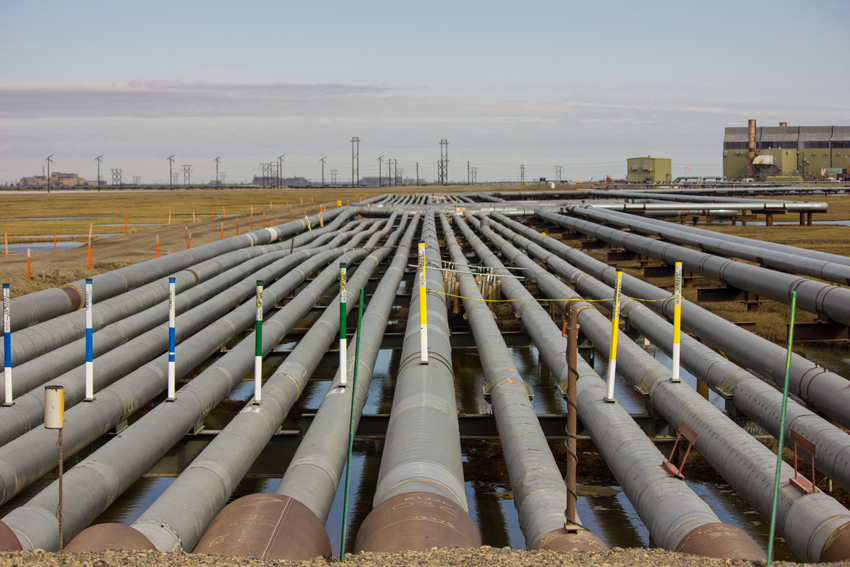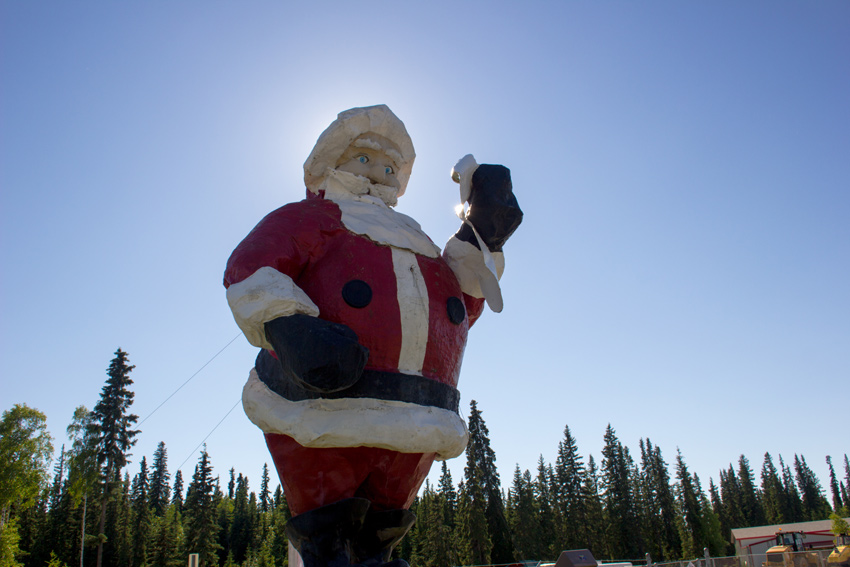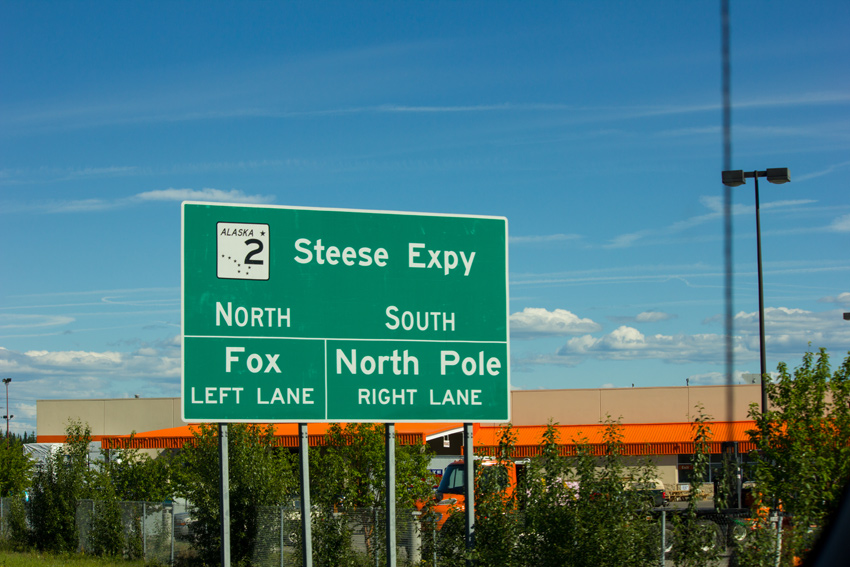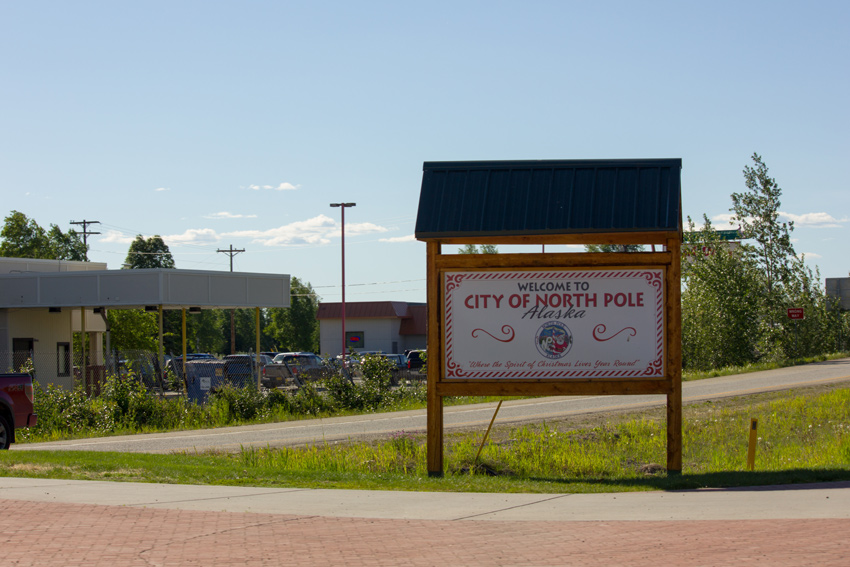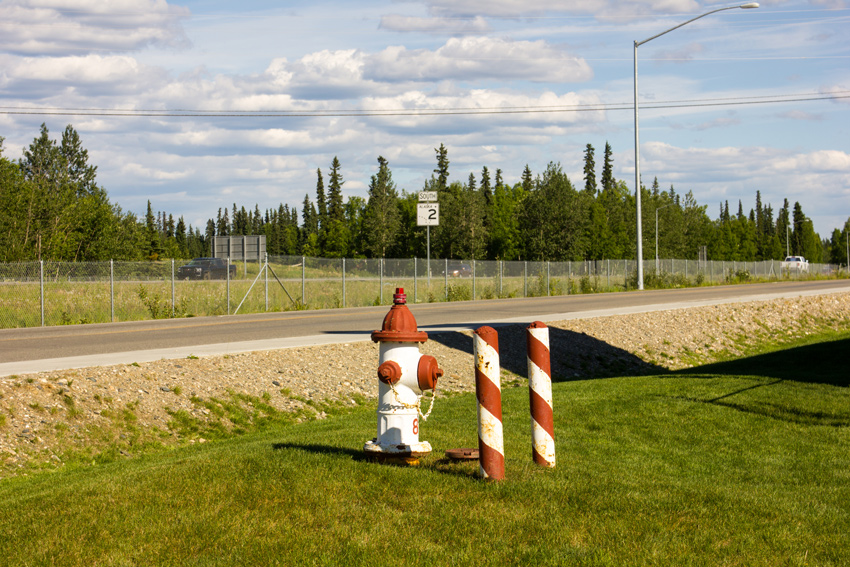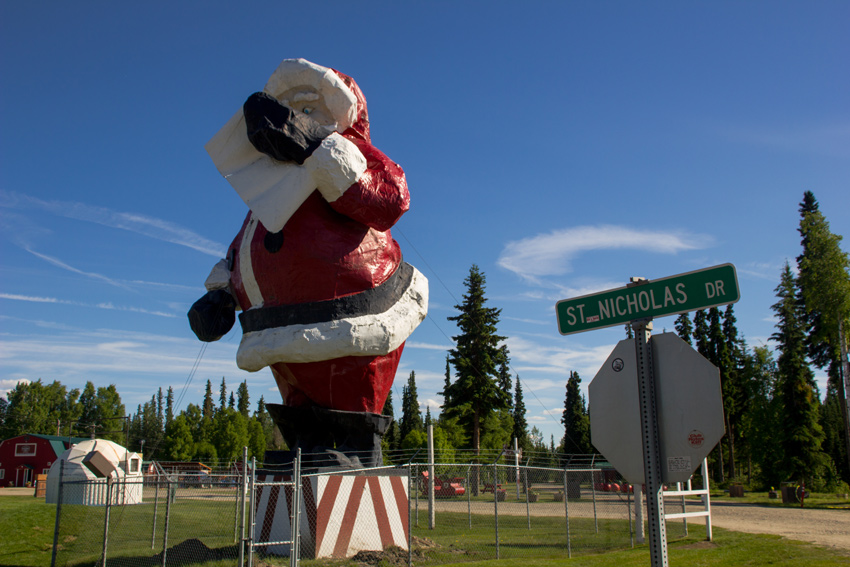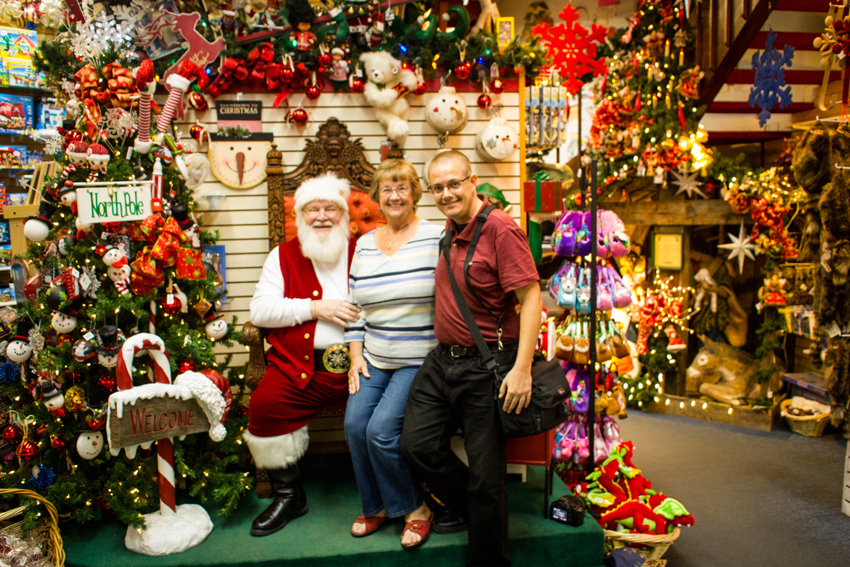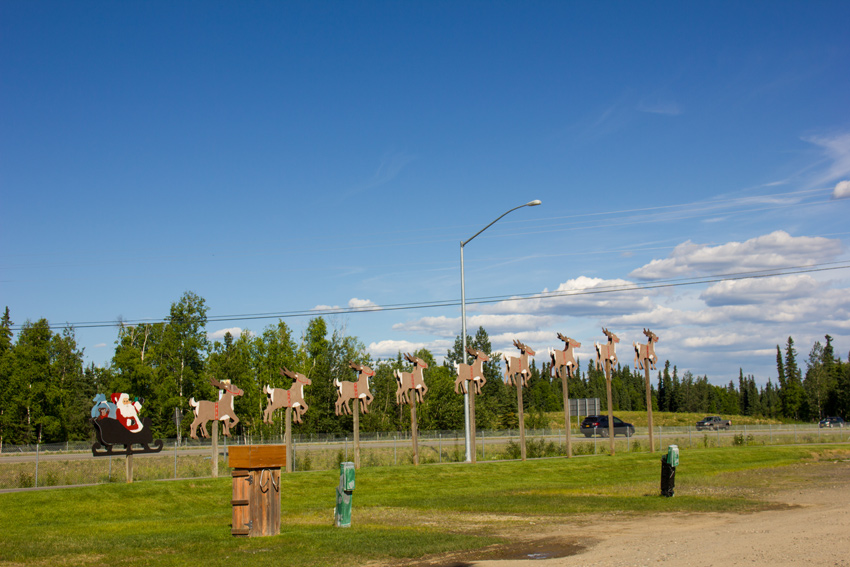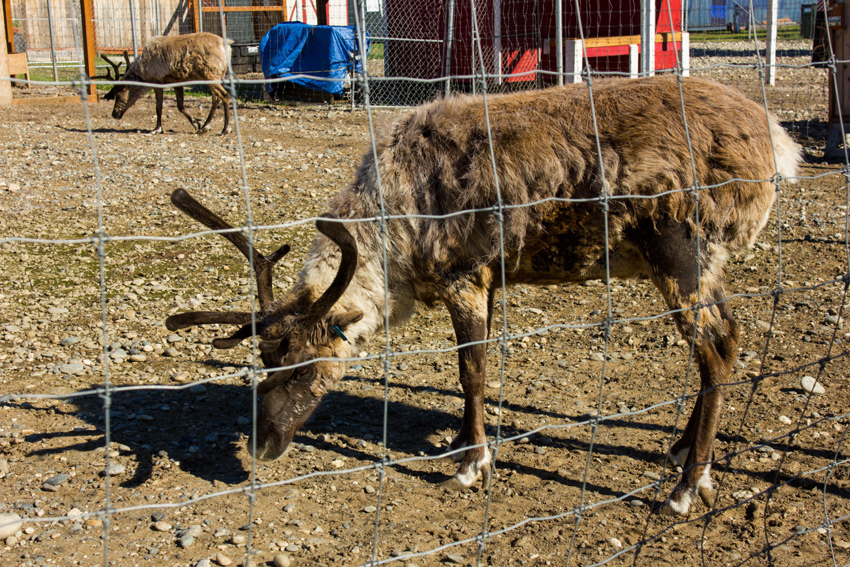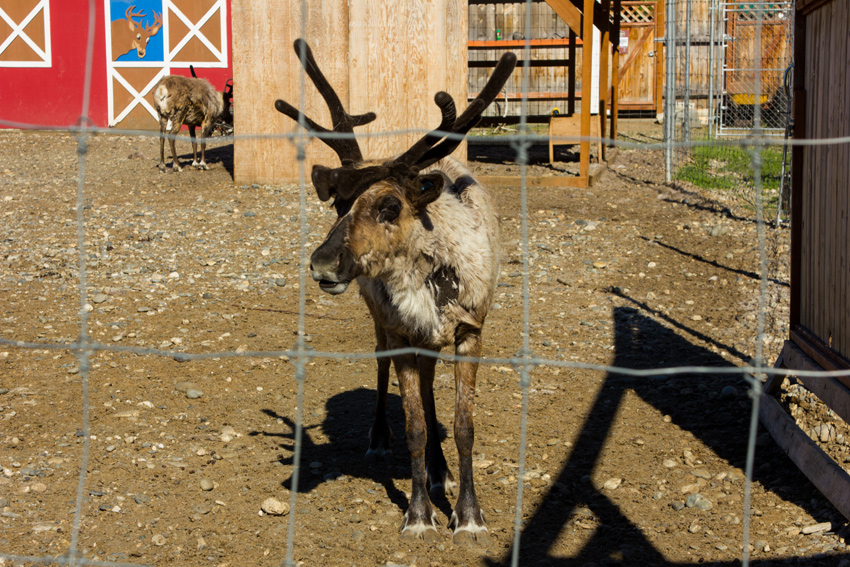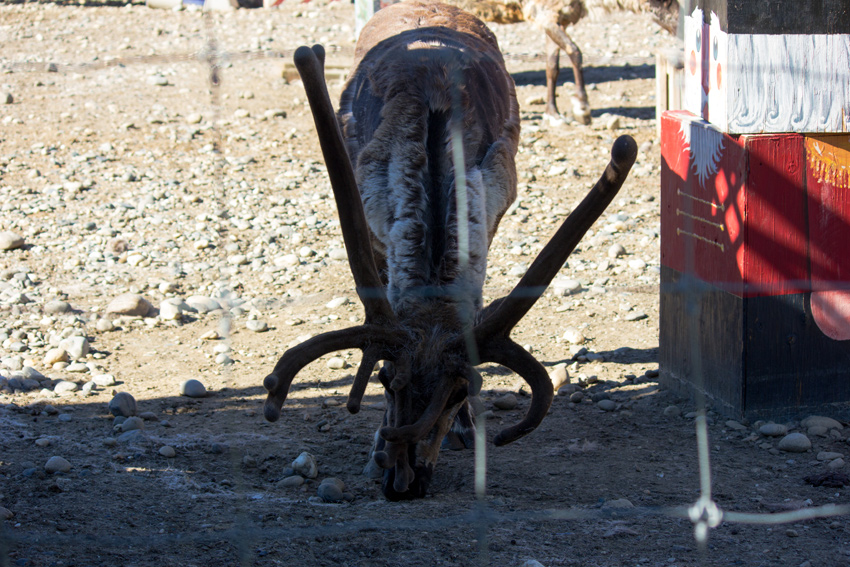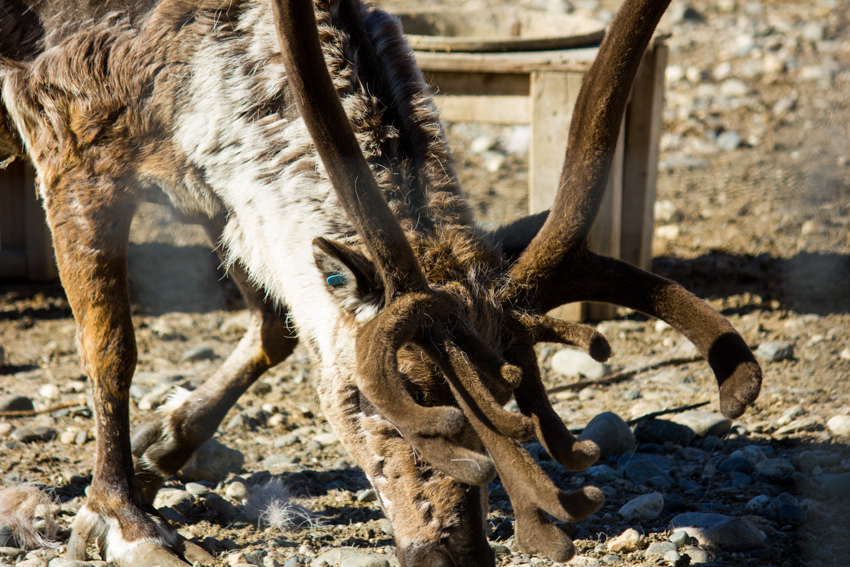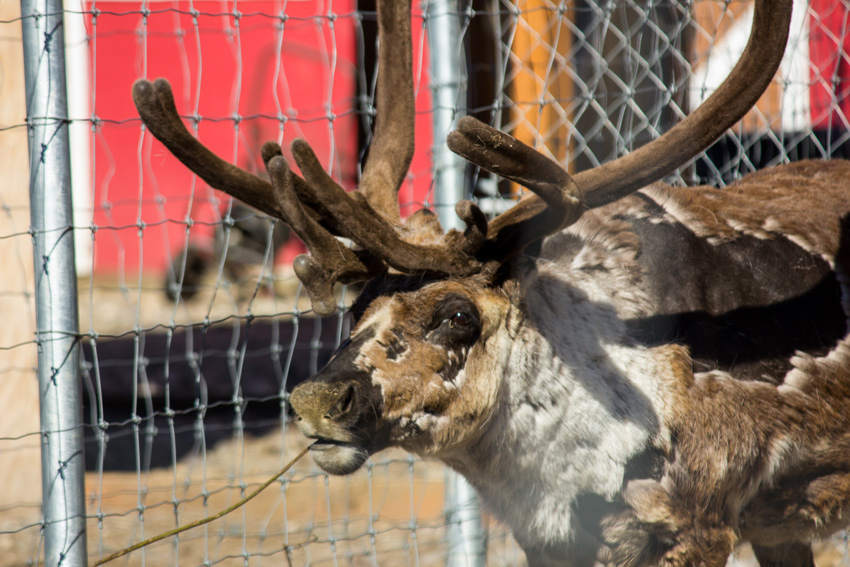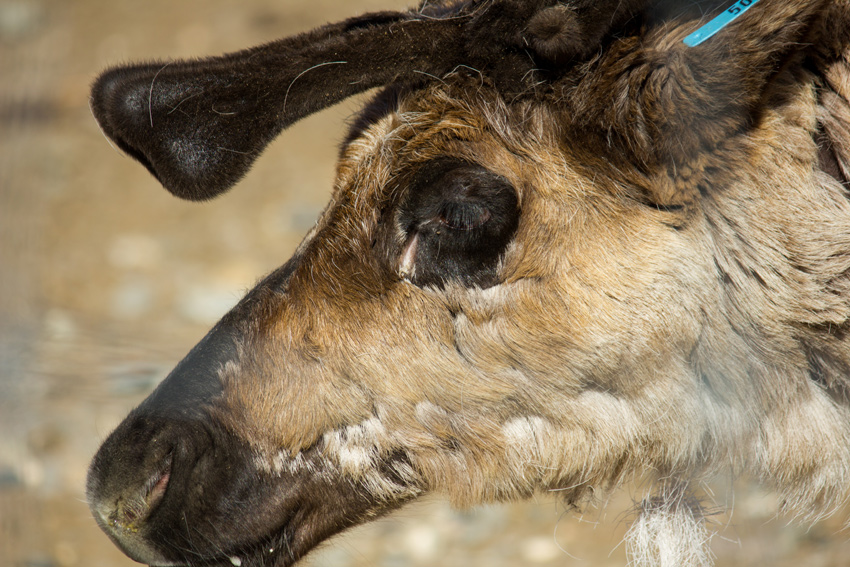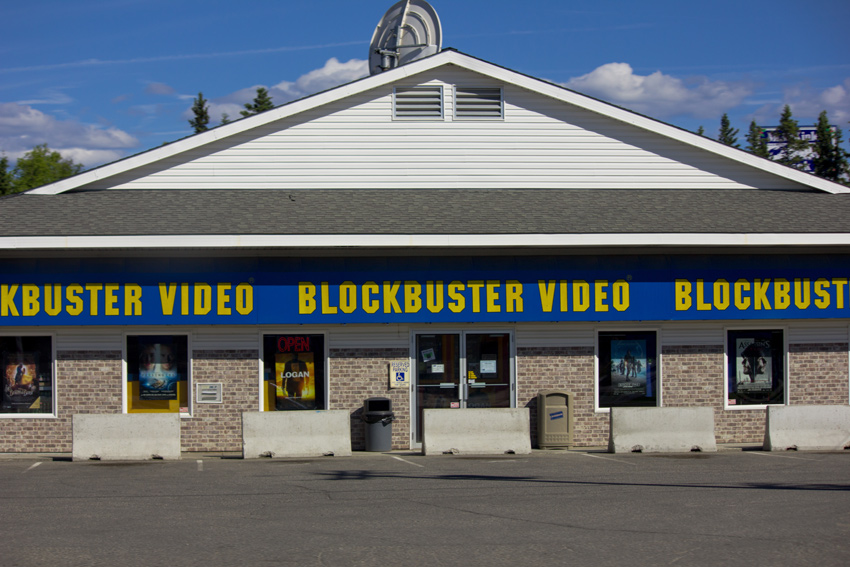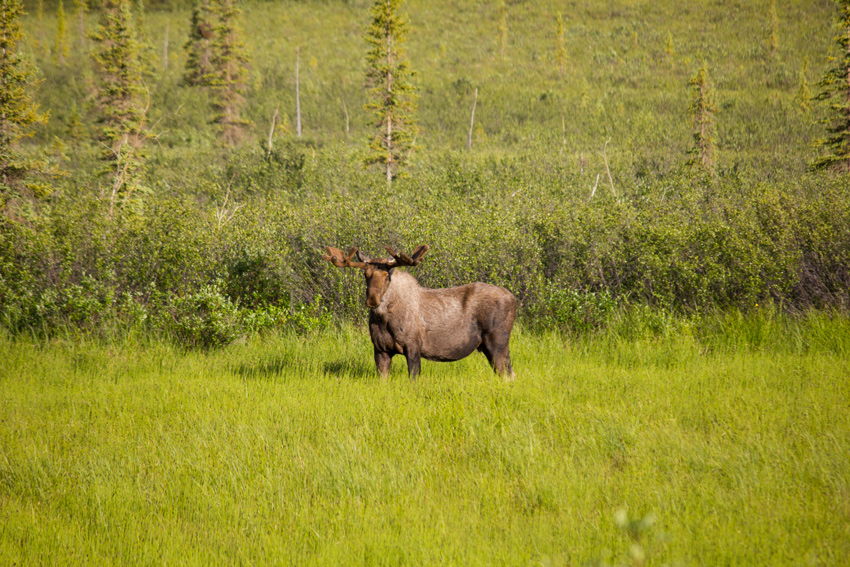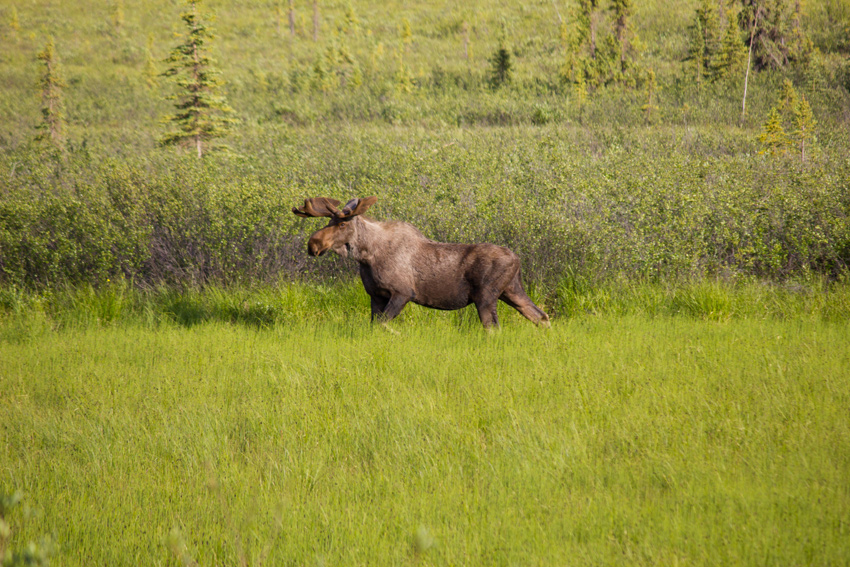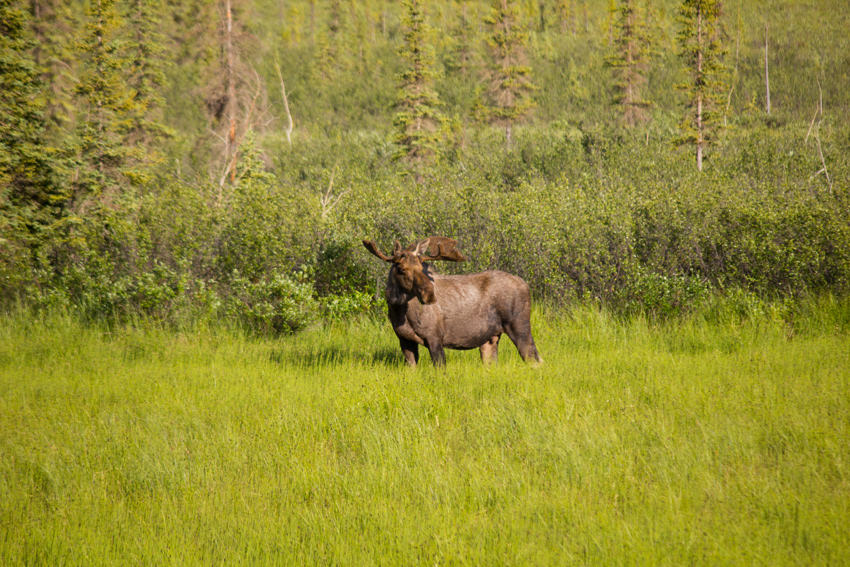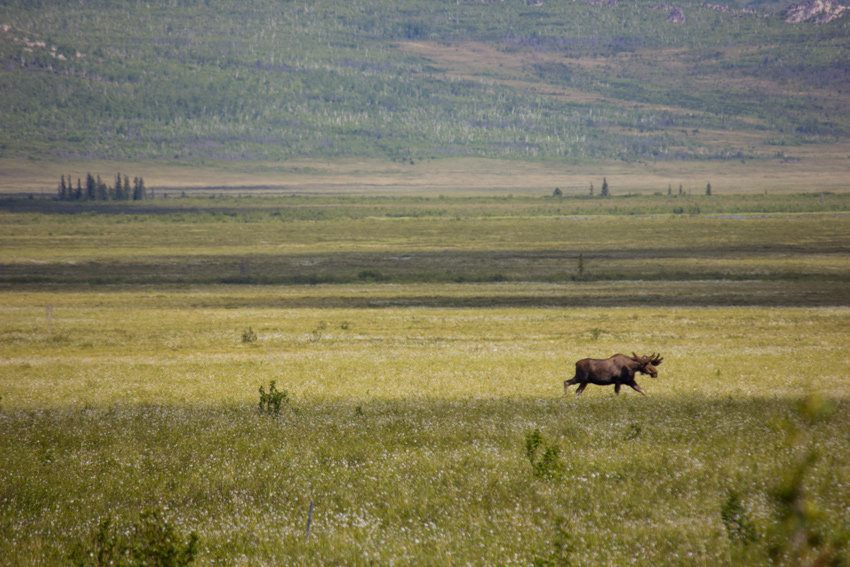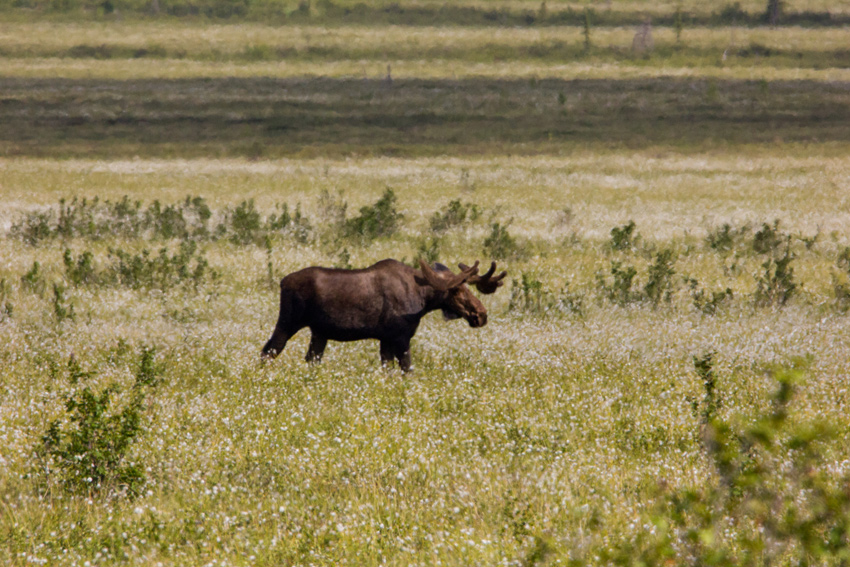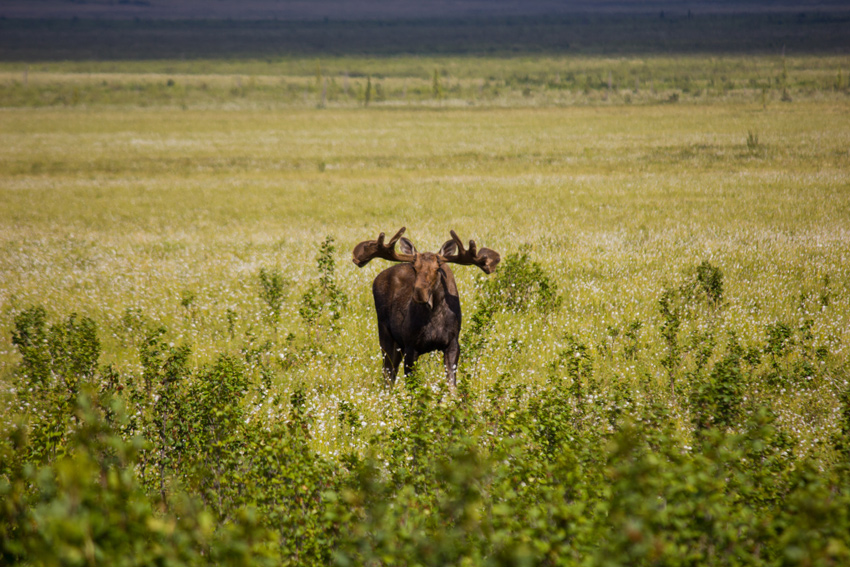Seventeen parallel flowlines running between Flow Station 2 and Drill Site 3, Drill Site 9, Drill Site 16, Drill Site 17 and Endicott at the Prudhoe Bay Oil Field.
East Dock Road, Prudhoe Bay, Alaska: 25 June 2017
part of the Alaska 2017: Prudhoe Bay and Deadhorse album
The Most Famous Reindeer Of All
A forty-two-foot tall, 900-pound fiberglass Santa Claus statue (1968) by Wes Stanley of Stanley Plastics, Enumclaw, Washington on display near the Santa Claus House (1952).
125 Saint Nicholas Drive, North Pole, Alaska: 14 June 2017
part of the Alaska 2017: North Pole album
Serving as a home base of sorts, Fairbanks was the first and last place I visited during my Alaska adventure. Following my first day of exploring the golden heart city, Mom suggested that we visit another nearby town before it got too late in the day. You may not have to worry about it getting dark at night during the summer, but businesses still do have normal hours of operation.
Situated by the Tanana River about fifteen miles southeast of Downtown Fairbanks, North Pole is the city "where the spirit of Christmas lives year round." The origins of the settlement that would become North Pole are tied to the arrival of Bon and Bernice Davis in Fairbanks on Friday, 07 April 1944. Driving from Fairbanks down the Richardson Highway, the Davises stopped at Milepost 15 to get out and walk around. Heading "several hundred yards" down the abandoned Richardson Trail, they decided that they had found the place of their new homestead, a 160-acre tract of land filled with scrub trees and brush.
Although not part of their original plan, a community formed around the Davises as they subdivided and sold off parcels of their land to other homesteaders. In 1948, the construction of a military railroad line through the area gave rise to the community's first name, Davis. This name was selected by the National Board of Geographic Names to designate a new railway switch built on Bon and Bernice's property. Over the next four years, continued growth and subdivisions eventually led the Dahl and Gaske Development Company to purchase the Davis subdivision and most of the homestead in February 1952.
It was Dahl and Gaske who thought renaming the community to "North Pole" would attract businesses such as toy manufacturers. Their petition to the United States District Court was heard by Judge Harry Pratt, who thought the "idea was far-fetched" but approved it nevertheless. Although not everyone was keen to incorporate, especially those residing in the Highway Park subdivision, residents of the Davis homestead and part of another voted to form the City of North Pole, officially established on Thursday, 15 January 1953.
Back in 1949, not long after Davis got its first name, Con B. Miller (1914–1996) and his wife Nellie Miller (1916–2008) moved to the Territory of Alaska with their two children and $1.40 to start a new life. Coming from the lower forty-eight where World War II veteran Con had "attempted to establish several businesses […] all of which faltered," the Millers first moved to Anchorage but, not caring for it there, relocated to Fairbanks. Con established himself as a merchant and fur buyer in Fairbanks and the surrounding villages, where he became well-known by local children for appearing in a red Santa suit each Christmas.
Borrowing $300 to get started, Con and Nellie decided in 1952 to move to North Pole and build a trading post selling general merchandise, groceries and pharmaceuticals. While working on the new store, a young boy recognized Con and said, "Hello, Santa Claus! Are you building a new house?" This interaction gave Con the inspiration to name the store Santa Claus House. Given its location in developing North Pole between Eielson Air Force Base and Ladd Air Force Base (now Fort Wainwright), Santa Claus House prospered as a general store, soda fountain and post office — "Santa Claus House was a mail contract station and served as North Pole's first post office for almost twenty years" with Nellie as postmaster.
Beyond the operation of Santa Claus House, the Millers also participated in the community's local government. When the City of North Pole was established in 1953, Con was one of five members of the first city council. He would go on to serve as city mayor for nineteen years, while Nellie "acted as marriage commissioner for the community, marrying thousands of couples inside Santa Claus House." The Millers' two sons would also go on to be politically involved. Terrence B. "Terry" Miller (1942–1989) served in the Alaska House of Representatives (1966–1969), Alaska Senate (1969–1977), as Lieutenant Governor (1978–1982) and on city and borough councils. Present-day Santa Claus House owner Mike W. Miller (1951–) also served on the North Pole City Council (1976–1980) as well as in the Alaska House (1983–1992) and Senate (1993–2000).
Following the 1972 realignment of the Richardson Highway, the Santa Claus House moved to its present location and as time went on became less of a trading post and more of a Christmas shop. Subsequent additions included the construction of a new wing and the installation of a forty-two-foot tall, 900-pound fiberglass Santa Claus statue. Originally made in 1968 by Wes Stanley of Stanley Plastics in Enumclaw, Washington, the "statue was the prototype for three giant Santa statues constructed that year." In 1978, Con Miller purchased it in Anchorage for $4,500, disassembled it into four pieces and then had it transported to North Pole by truck. Following a restoration and repair process, the statue was installed in 1983. It was moved about 140 feet just eight days after our visit "to make room for an expansion of the gift shop, as well as to relocate it away from the road for safety purposes."
Upon our arrival at Santa Claus House, we did something in June only possible here in North Pole… visit with Santa himself.
The entirety of the facility is dedicated to Christmas-themed retail of every sort imaginable plus a counter selling coffee and homemade fudge. There is also a large stuffed moose and polar bear waiting to pose with visitors in the original part of the building. Lining the wall of the corridor outside the restrooms is a large selection of humorous or touching letters from children sent to the store for Santa.
Returning outside, we walked next door to inspect the aforementioned Santa statue and painted wooden cut-outs of Santa in his sled being pulled by nine reindeer. The area behind was obviously once a campground, but was no longer in operation. Indeed, Santaland RV Park has been at this location since at least 1992. The eighty-five site campground was acquired by the Santa Claus House in 2000, managed by Mike Miller's daughter Teffonie Wyman and her husband Phillip. When the Wymans decided to move on after the 2010 season, Miller announced his intention to focus on their core business ("provide a unique and exciting shopping experience for Christmas lovers of all ages") and the Santaland RV Park did not reopen in 2011.
Inside what once was Santaland RV, we found a large fenced-in area that was home to a number of semi-domesticated caribou (Rangifer tarandus granti) or reindeer. Reindeer have been kept here since at least 2001 and a formal exhibit called "Antler Academy of Flying and Reindeer Games" opened sometime between 2013 and 2016. Antler Academy, which did not seem to be open during our visit, allows visitors to feed and touch the reindeer while learning more about them from a tour guide. Instead, we watched them eat and move about from outside the fence.
Done visiting with the reindeer, we made our way back to Fairbanks for dinner along the Chena River at Pike's Landing. Although our time in North Pole was brief, Mom was correct in that it was someplace unique and worth visiting.
Visit the Fairbanks and North Pole albums to see all twenty-seven published photographs from my trip to North Pole.
The Wildflower Seed On The Sand And Wind
Common dandelion (Taraxacum officinale) seed head growing along the southern perimeter of Creamer's Field Migratory Waterfowl Refuge.
Danby Street, Fairbanks, Alaska: 14 June 2017
part of the Alaska 2017: Fairbanks album
The Coin That Will Not Get Tossed
Blockbuster Video retail store still open for business in North Pole, Alaska.
320 North Santa Claus Lane, North Pole, Alaska: 14 June 2017
part of the Alaska 2017: North Pole album
Did you know that Blockbuster Video still has retail locations in business? I did not until Wednesday, 14 June 2017, when I spotted one in Fairbanks and another in nearby North Pole, Alaska. I would pass a third location in Wasilla a few days later. Although there are many unique and wonderful aspects to the forty-ninth state, the sight of Blockbuster Video stores was unanticipated and rather surprising. Knowing that I would learn more after the trip, I hypothesized that high-speed internet must not be widely available or is still too expensive for Alaskans to switch to streaming services.
Even when they were ubiquitous, I never cared for Blockbuster Video. My first experience with them was in the early 1990s after they took over a local video store in Altamonte Springs, Florida where I used to rent movies on VHS cassette as well as the occasional Nintendo game. I recall Blockbuster trying to overcharge by adding late fees for items previously returned on time, that is when they actually had the titles I wanted in stock.
As it turns out, I saw half of the Blockbuster stores still open today in Alaska. In addition to the ones in Fairbanks, North Pole and Wasilla, there are also two stores in Anchorage plus one in Soldotna near Kenai. The six Alaska locations are not the only surviving ones, however; there are also three stores in Oregon and one in Texas for a total of ten nationwide. Despite their continued operation, Blockbuster and other independently-owned video stores in Alaska have not been completely immune to the shifts in how people consume film and television media.
When Dish Network, the satellite television provider that acquired Blockbuster in 2011, announced the closure of the final 300 remaining corporate stores on Wednesday, 06 November 2013, there were thirteen locations in Alaska staying open. As the Midtown Anchorage location prepared to close in September 2016, it was noted that Kenai's store closed earlier in 2016 and that "other locations in Juneau, Kodiak and Anchorage have also gone in recent years." Most recently, the store in Eagle River northeast of Anchorage closed in July 2017.
Returning to my hypothesis, articles published on Wednesday, 26 April 2017 and Sunday, 30 July 2017 support my original conclusion — "internet service is substantially more expensive than in most states, since most data packages are not unlimited." There are additional contributory factors, however.
First, Alaska has a strong but small retail market. Even as stores in the lower forty-eight close, locations in Alaska frequently remain open. Reasons cited include a lack of retail supersaturation, fewer competing businesses and the high cost (and long wait times) for shipping items purchased online to Alaska addresses. Second, many Alaskans have higher median household incomes than in other states. Third, Alaskans maintain a desire to use retail outings to socialize in a place where winter is very cold, dark and long.
Even as their website proclaims that "Blockbuster stores may be a thing of the past," there continues to be a market in Alaska for the traditional way of browsing the rows and rows of titles and renting videos for home entertainment. With the closures over the past two years alone, Blockbuster's future and that of local video retailers is far from certain in the last frontier. Even if broadband internet becomes more affordable, there is still the social aspect to help keep the businesses afloat. I may feel no nostalgia for Blockbuster, but the closure of the remaining video stores in Alaska will signal the unfortunate conclusion of an era.
The Cat And Moose Game
A moose (Alces alces) bull browsing and eating grassy vegetation next to the Dalton Highway (AK 11).
MP 193.9 James W. Dalton Highway, Yukon-Koyukuk, Alaska: 25 June 2017
part of the Alaska 2017: Prudhoe Bay to Coldfoot album
As numerous as they were across the region — see "The Moose On The Loose" and "The State Mammal Of Alaska" — most of the moose I encountered were either cows or cows with calves. Fortunately, I did see at least four moose bulls including two while driving southbound on the James W. Dalton Highway.
The first Dalton bull was browsing and eating grassy vegetation southeast of the highway when we drove up and then stopped to check him out. Although it looked our way a few times during the five minutes we watched, this moose was not interested in or concerned by our presence instead staying focused on his foraging. As we were seven hours into our drive with thirty minutes left to Coldfoot, I resumed our course south and left this moose to his herbivorous meal.
We encountered a second bull the following day after being on the road for three hours and fifteen minutes. Spotting the bull walking south through grassy flatlands east of the Dalton, I pulled over into a Trans-Alaska Pipeline access road not far from the site of Old Man Camp (1974–1977), one of thirty-one temporary construction facilities that housed the thousands of workers who built the pipeline.
The moose was walking at a rather rapid pace, focused on an unknown destination without browsing or eating any of the grasses he passed through. After a few minutes, the moose was at his closest point to us not only latitudinally but longitudinally as well. Almost as if the moose was preoccupied in thought and then suddenly noticed us sitting there, he stopped suddenly to look at us head-on. A minute passed before he turned around and walked east away from the road, apparently wanting no part of us.
Visit the Prudhoe Bay to Coldfoot and Coldfoot to Fairbanks albums to see all fifteen published photographs of these moose bulls.







